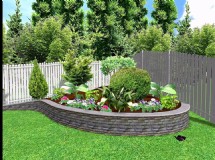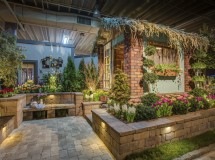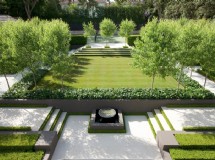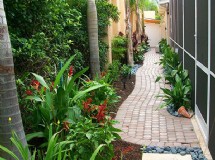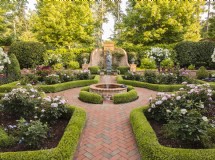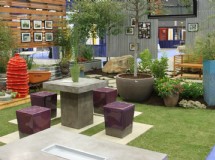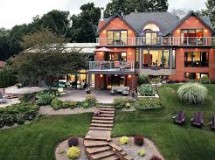Individual brick concrete paver pieces are used to pave driveways, patios, walkways, pool decks, and loading decks. Pavers will usually be used as an exterior pavement solution replacing other methods of pavement or ground covers. Pavers will be installed on compacted sub base and concrete sand with minimum of 90% compaction. Cement parameter will hold everything in place and sand will be swept on the top surface to interlock and prevent movement.
Other materials exist in the market like rubber pavers, glass pavers, plastic and clay. Clay pavers, also called brick pavers, provide an advantage of color resistance since they are made from natural materials and are oven baked.
Interlocking pavers were brought from Europe in the early 70's and were commonly used with natural stone pavers in street and houses. Today most projects use concrete pavers due to the many advantages over other pavement methods, for example: Interlocking pavers support heavy weight and are manufactured as individual pieces with a high compression process (min 8000 psi). Pavers don't crack since the joints absorb pressure differences over the top surface. Pavers are low in maintenance and do not require any future treatment compared to asphalt and stamped concrete. Another big advantage with using pavers is that they are easy and inexpensive to repair. Dealing with repairs and stains will be faster and cheaper than with any other method and will not look like a patch.
Pavers phoenix are available in a wide range of colors and designs to choose from. Today, pavers are commonly used on residential and commercial projects for their elegant and or old look as well as for their low maintenance with results that last a life time.
About pavers and ground compaction
Ground compaction is the most important stage in paver's installation; this is the stage you will have to put extra attention to in order to avoid repairs in the future, most problems with pavers occur from poor compaction.
Depending on the type of soil, you will have to add sub base, usually ABC and concrete or coerces sand, in some cases the ground is rocky and it's enough do add concrete sand only.
Ground compaction is necessary to avoid sinking, movement, and to support the weight that the paved area was designed to take. Good ground compaction also eliminates weed growth and erosion.
Compaction is needed every 1" of fill. Compaction that is done towards the end of the project on top of the pavers is not effective due to the thickness and the fact that the vibrations don't reach all the way down. Compaction on the top surface only helps speed up the sweeping process and shouldn't be substituted to compaction before laying the pavers on the ground.
Before installing pavers 95% of compaction is needed, that can be reached only with the right type of soil, the necessary conditions, and tools.
Ground compaction can't be done when soil is soaked with water (more than 25%), then when the water gets dry, the air takes place and creates pockets that will sink and generate movement in the future. In this case the installer should replace the soaked soil with dry ABC or wait until it dries.
Other materials exist in the market like rubber pavers, glass pavers, plastic and clay. Clay pavers, also called brick pavers, provide an advantage of color resistance since they are made from natural materials and are oven baked.
Interlocking pavers were brought from Europe in the early 70's and were commonly used with natural stone pavers in street and houses. Today most projects use concrete pavers due to the many advantages over other pavement methods, for example: Interlocking pavers support heavy weight and are manufactured as individual pieces with a high compression process (min 8000 psi). Pavers don't crack since the joints absorb pressure differences over the top surface. Pavers are low in maintenance and do not require any future treatment compared to asphalt and stamped concrete. Another big advantage with using pavers is that they are easy and inexpensive to repair. Dealing with repairs and stains will be faster and cheaper than with any other method and will not look like a patch.
Pavers phoenix are available in a wide range of colors and designs to choose from. Today, pavers are commonly used on residential and commercial projects for their elegant and or old look as well as for their low maintenance with results that last a life time.
About pavers and ground compaction
Ground compaction is the most important stage in paver's installation; this is the stage you will have to put extra attention to in order to avoid repairs in the future, most problems with pavers occur from poor compaction.
Depending on the type of soil, you will have to add sub base, usually ABC and concrete or coerces sand, in some cases the ground is rocky and it's enough do add concrete sand only.
Ground compaction is necessary to avoid sinking, movement, and to support the weight that the paved area was designed to take. Good ground compaction also eliminates weed growth and erosion.
Compaction is needed every 1" of fill. Compaction that is done towards the end of the project on top of the pavers is not effective due to the thickness and the fact that the vibrations don't reach all the way down. Compaction on the top surface only helps speed up the sweeping process and shouldn't be substituted to compaction before laying the pavers on the ground.
Before installing pavers 95% of compaction is needed, that can be reached only with the right type of soil, the necessary conditions, and tools.
Ground compaction can't be done when soil is soaked with water (more than 25%), then when the water gets dry, the air takes place and creates pockets that will sink and generate movement in the future. In this case the installer should replace the soaked soil with dry ABC or wait until it dries.
SHARE

